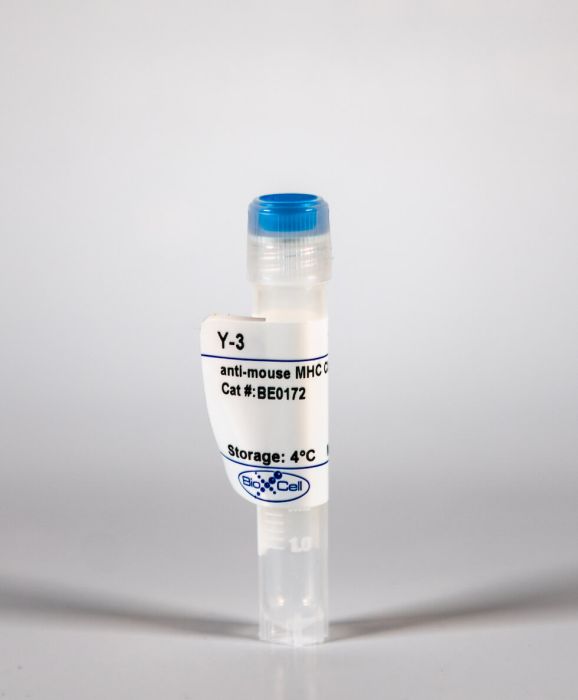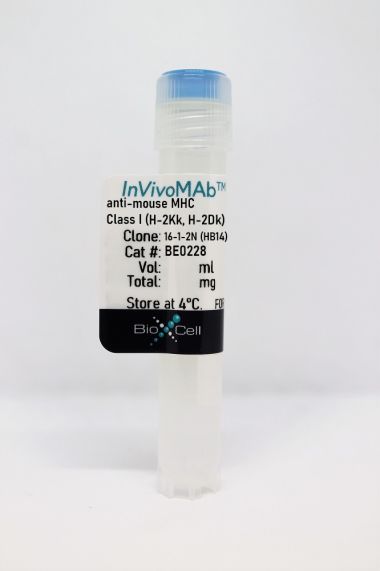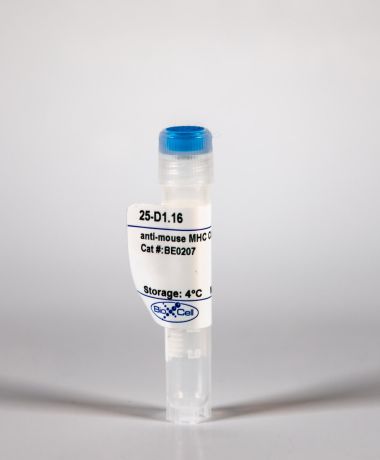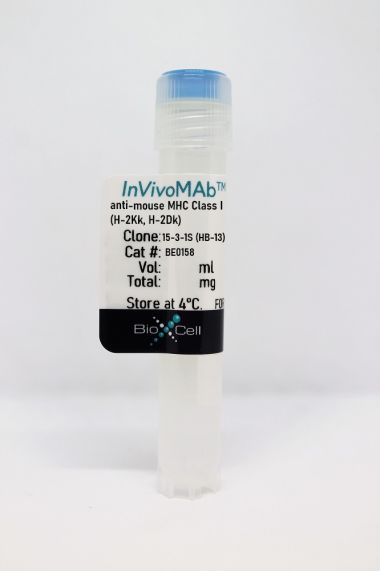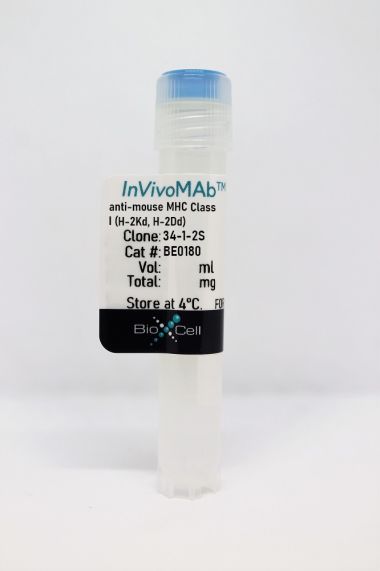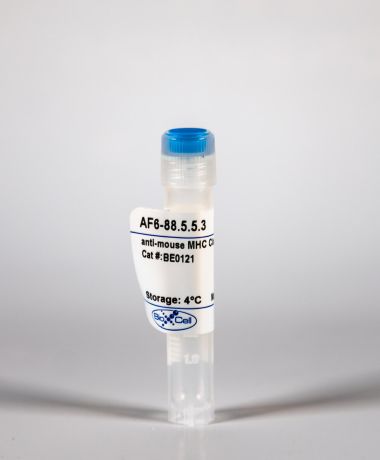InVivoMAb anti-mouse MHC Class I (H-2Kb)
Product Details
The Y-3 monoclonal antibody is reported to react with the mouse H-2Kb, H-2Kk, H-2Kq, H-2Kr, H-2ksand not H-2Kd MHC class I alloantigens. MHC class I antigens are heterodimers consisting of one alpha chain (44 kDa) associated with β2 microglobulin (11.5 kDa). The antigen is expressed by all nucleated cells at varying levels. MHC Class I molecules present endogenously synthesized antigenic peptides to CD8 T cells.Specifications
| Isotype | Mouse IgG2b, κ |
|---|---|
| Recommended Isotype Control(s) | InVivoMAb mouse IgG2b isotype control, unknown specificity |
| Recommended Dilution Buffer | InVivoPure pH 7.0 Dilution Buffer |
| Conjugation | This product is unconjugated. Conjugation is available via our Antibody Conjugation Services. |
| Immunogen | Con A stimulated spleen cells from BALB.B mice |
| Reported Applications |
in vivo MHC II blockade Functional assays Purification of MHC peptide complexes Flow cytometry |
| Formulation |
PBS, pH 7.0 Contains no stabilizers or preservatives |
| Endotoxin |
<2EU/mg (<0.002EU/μg) Determined by LAL gel clotting assay |
| Purity |
>95% Determined by SDS-PAGE |
| Sterility | 0.2 µm filtration |
| Production | Purified from cell culture supernatant in an animal-free facility |
| Purification | Protein G |
| RRID | AB_10949300 |
| Molecular Weight | 150 kDa |
| Storage | The antibody solution should be stored at the stock concentration at 4°C. Do not freeze. |
Recommended Products
in vivo MHC II blockade
Baptista, A. P., et al. (2019). "The Chemoattractant Receptor Ebi2 Drives Intranodal Naive CD4(+) T Cell Peripheralization to Promote Effective Adaptive Immunity" Immunity 50(5): 1188-1201.e1186. PubMed
Lymph nodes (LNs) play critical roles in adaptive immunity by concentrating in one location the antigens, antigen-presenting cells, and antigen-responsive lymphocytes involved in such responses. Recent studies have revealed nonrandom localization of innate and adaptive immune cells within these organs, suggesting that microanatomical positioning optimizes responses involving sparse cooperating cells. Here, we report that the peripheral localization of LN cDC2 dendritic cells specialized for MHC-II antigen presentation is matched by a similarly biased paracortical distribution of CD4(+) T cells directed by the chemoattractant receptor Ebi2. In the absence of Ebi2, CD4(+) T cells lose their location bias and are delayed in antigen recognition, proliferative expansion, differentiation, direct effector activity, and provision of help for CD8(+) T cell-mediated memory responses, limiting host defense and vaccine responses. These findings demonstrate evolutionary selection for distinct niches within the LN that promote cellular responses, emphasizing the critical link between fine-grained tissue organization and host defense.
Flow Cytometry
Reed, B. K., et al. (2015). "A Versatile Simple Capture Assay for Assessing the Structural Integrity of MHC Multimer Reagents" PLoS One 10(9): e0137984. PubMed
Antigen-specific T cell responses can be visualized using MHC:peptide multimers. In cases where robust T cell controls are not readily available to assess the integrity of multimer reagents prior to analyzing limited sample, the ability to assess the structural integrity of MHC multimers before their use in critical experiments would be useful. We present a method to probe the structural integrity of MHC multimers using antibodies specific for conformational determinants. Beads coated with anti-mouse Ig are incubated with conformation-specific mouse monoclonal antibody and then with fluorescently tagged MHC multimer. The ability of the bead to capture the labeled multimer can be measured semi-quantitatively by flow cytometry. In this manner, the correct folding of MHC multimers can be visualized and batches of multimer can be compared for quality control. Because there are multiple conformational epitopes formed by various molecular interactions among heavy chain, peptide, and beta2M, this capture assay can assess the fidelity of each aspect of multimer structure, depending on the availability of antibodies. The described approach could be particularly useful for studies using irreplaceable samples, including patient samples collected in clinical trials.
Flow Cytometry
Zanker, D., et al. (2015). "T cells recognizing a 11mer influenza peptide complexed to H-2D(b) show promiscuity for peptide length" Immunol Cell Biol 93(5): 500-507. PubMed
T-cell repertoire is selected according to self peptide-MHC (major histocompatibility complex) complexes in the thymus. Although most peripheral T cells recognize specific pathogen-derived peptides complexed to self-MHC exclusively, some possess cross-reactivity to other self or foreign peptides presented by self-MHC molecules; a phenomenon often termed T-cell receptor (TCR) promiscuity or degeneracy. TCR promiscuity has been attributed to various autoimmune conditions. On the other hand, it is considered a mechanism for a relatively limited TCR repertoire to deal with a potentially much larger antigenic peptide repertoire. Such property has also been utilized to bypass self-tolerance for cancer vaccine development. Although many studies explored such degeneracy for peptide of the same length, few studies reported such properties for peptides of different length. In this study, we finely characterized the CD8(+) T-cell response specific for a 11mer peptide derived from influenza A viral polymerase basic protein 2. The short-term T-cell line, despite possessing highly biased TCR, was able to react with multiple peptides of different length sharing the same core sequence. Out data clearly showed the importance of detailed and quantitative assessments for such T-cell specificity. Our data also emphasize the importance of biochemical demonstration of the naturally presented minimal peptide.
Purification of MHC peptide complexes
Trujillo, J. A., et al. (2014). "Structural and functional correlates of enhanced antiviral immunity generated by heteroclitic CD8 T cell epitopes" J Immunol 192(11): 5245-5256. PubMed
Peptides that bind poorly to MHC class I molecules often elicit low-functional avidity T cell responses. Peptide modification by altering the anchor residue facilitates increased binding affinity and may elicit T cells with increased functional avidity toward the native epitope (“heteroclitic”). This augmented MHC binding is likely to increase the half-life and surface density of the heteroclitic complex, but precisely how this enhanced T cell response occurs in vivo is not known. Furthermore, the ideal heteroclitic epitope will elicit T cell responses that completely cross-react with the native epitope, maximizing protection and minimizing undesirable off-target effects. Such epitopes have been difficult to identify. In this study, using mice infected with a murine coronavirus that encodes epitopes that elicit high (S510, CSLWNGPHL)- and low (S598, RCQIFANI)-functional avidity responses, we show that increased expression of peptide S598 but not S510 generated T cells with enhanced functional avidity. Thus, immune responses can be augmented toward T cell epitopes with low functional avidity by increasing Ag density. We also identified a heteroclitic epitope (RCVIFANI) that elicited a T cell response with nearly complete cross-reactivity with native epitope and demonstrated increased MHC/peptide abundance compared with native S598. Structural and thermal melt analyses indicated that the Q600V substitution enhanced stability of the peptide/MHC complex without greatly altering the antigenic surface, resulting in highly cross-reactive T cell responses. Our data highlight that increased peptide/MHC complex display contributes to heteroclitic epitope efficacy and describe parameters for maximizing immune responses that cross-react with the native epitope.
Functional Assays
Bose, T. O., et al. (2013). "CD11a regulates effector CD8 T cell differentiation and central memory development in response to infection with Listeria monocytogenes" Infect Immun 81(4): 1140-1151. PubMed
beta2 (CD18) integrins with alpha-chains CD11a, -b, -c, and -d are important adhesion molecules necessary for leukocyte migration and cellular interactions. CD18 deficiency leads to recurrent bacterial infections and poor wound healing due to reduced migration of leukocytes to inflammatory sites. CD8 T cells also upregulate CD11a, CD11b, and CD11c upon activation. However, the role these molecules play for CD8 T cells in vivo is not known. To determine the function of individual beta2 integrins, we examined CD8 T cell responses to Listeria monocytogenes infection in CD11a-, CD11b-, and CD11c-deficient mice. The absence of CD11b or CD11c had no effect on the generation of antigen-specific CD8 T cells. In contrast, the magnitude of the primary CD8 T cell response in CD11a-deficient mice was significantly reduced. Moreover, the response in CD11a(-/-) mice exhibited reduced differentiation of short-lived effector cells (KLRG1(hi) CD127(lo)), although cytokine and granzyme B production levels were unaffected. Notably, CD11a deficiency resulted in greatly enhanced generation of CD62L(+) central memory cells. Surprisingly, CD8 T cells lacking CD11a mounted a robust secondary response to infection. Taken together, these findings demonstrated that CD11a expression contributes to expansion and differentiation of primary CD8 T cells but may be dispensable for secondary responses to infection.
Purification of MHC peptide complexes, Flow Cytometry
Croft, N. P., et al. (2013). "Kinetics of antigen expression and epitope presentation during virus infection" PLoS Pathog 9(1): e1003129. PubMed
Current knowledge about the dynamics of antigen presentation to T cells during viral infection is very poor despite being of fundamental importance to our understanding of anti-viral immunity. Here we use an advanced mass spectrometry method to simultaneously quantify the presentation of eight vaccinia virus peptide-MHC complexes (epitopes) on infected cells and the amounts of their source antigens at multiple times after infection. The results show a startling 1000-fold range in abundance as well as strikingly different kinetics across the epitopes monitored. The tight correlation between onset of protein expression and epitope display for most antigens provides the strongest support to date that antigen presentation is largely linked to translation and not later degradation of antigens. Finally, we show a complete disconnect between the epitope abundance and immunodominance hierarchy of these eight epitopes. This study highlights the complexity of viral antigen presentation by the host and demonstrates the weakness of simple models that assume total protein levels are directly linked to epitope presentation and immunogenicity.
Functional Assays
Hammerling, G. J., et al. (1982). "Localization of allodeterminants on H-2Kb antigens determined with monoclonal antibodies and H-2 mutant mice" Proc Natl Acad Sci U S A 79(15): 4737-4741. PubMed
The topographic arrangement of antigenic determinants on the H-2Kb molecule was investigated by antibody competition studies with a series of monoclonal anti-Kb antibodies. For identification of amino acid residues participating in formation of allodeterminants H-2Kb mutant mice with defined amino acid substitutions were analyzed. The determinants were found to be located in at least two spatially separate clusters on the H-2Kb molecule. Determinants of one cluster are affected by mutations at amino acid positions 155 and 156, whereas determinants of a second cluster are modified by amino acid substitutions at positions 77 and 89. For a third cluster of determinants no relevant amino acid positions could be identified, but competition data indicate that this cluster is adjacent to the second one. The data suggest that the first two domains of H-2 antigens carry most allodeterminants.

